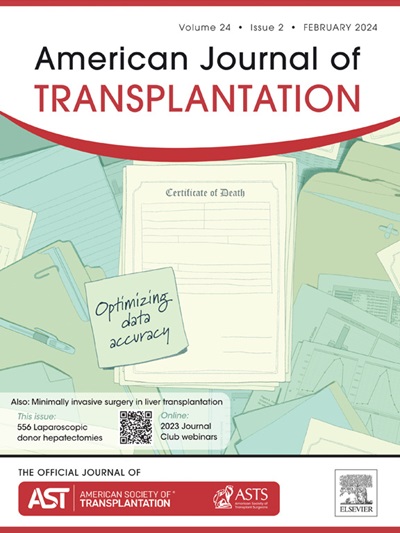儿童癌症后小儿肾脏替代治疗的临床结果 - ESPN/ERA 登记研究。
IF 8.9
2区 医学
Q1 SURGERY
引用次数: 0
摘要
癌症及其治疗可能会导致肾脏损伤,需要进行肾脏替代治疗(KRT)。我们从 ESPN/ERA 登记处确定了 287 名有恶性肿瘤病史的儿科 KRT 患者。其中,197 例癌症是导致 KRT 的主要原因(第 1 组),90 例在 KRT 前确诊为恶性肿瘤(第 2 组)。每名患者随机抽取两名无恶性肿瘤的匹配对照组。数据由问卷调查补充。第一组、其对照组、第二组及其对照组从开始 KRT 到肾移植(KT)的中位时间分别为 2.4 年(IQR:1.5-4.7)、1.5 年(IQR:0.4-3.3)、3.6 年(IQR:1.3-Q3 未达)和 1.1 年(IQR:0.3-3.6)。与对照组相比,第 1 组癌症患者接受 KRT 治疗后的 10 年总死亡率更高:16% 对 9%(aHR 2.02,95% CI:1.21-3.37),第 2 组癌症患者接受 KRT 治疗后的 10 年总死亡率更高:23% 对 14%(aHR 2.32,95% CI:1.11-4.85)。相比之下,首次 KT 后患者的 10 年生存率与对照组相当(第 1 组和第 2 组分别为 93% 对 96%;100% 对 94%)。总之,儿童癌症幸存者的 KT 被延迟,他们在 KRT 期间的总死亡率增加,但一旦接受移植,他们的长期预后与其他 KT 接受者相似。本文章由计算机程序翻译,如有差异,请以英文原文为准。
Clinical outcomes of pediatric kidney replacement therapy after childhood cancer—An ESPN/ERA Registry study
Cancer and its treatment may lead to kidney injury and the need for kidney replacement therapy (KRT). We identified 287 pediatric KRT patients with a history of malignancy from the European Society for Paediatric Nephrology/European Renal Association Registry. Of these, 197 had cancer as a primary cause of KRT (group 1) and 90 had a malignancy diagnosis before KRT (group 2). Two matched controls without malignancy were randomly selected for each patient. Data were complemented with a questionnaire. Median time to kidney transplantation (KT) from KRT initiation was 2.4 (IQR: 1.5-4.7), 1.5 (IQR: 0.4-3.3), 3.6 (IQR: 1.3 to Q3 not reached), and 1.1 (IQR: 0.3-3.6) years for group 1, their controls, group 2, and their controls, respectively. Overall 10-year mortality for those on KRT was higher among cancer patients vs controls in group 1: 16% vs 9% (adjusted hazard ratio 2.02, 95% CI: 1.21-3.37) and in group 2: 23% vs 14% (adjusted hazard ratio 2.32, 95% CI: 1.11-4.85). In contrast, 10-year patient survival after the first KT was comparable to controls (93% vs 96%; 100% vs 94%, in groups 1 and 2, respectively). In summary, childhood cancer survivors’ KT was delayed, and their overall mortality when on KRT was increased, but once transplanted, their long-term outcome was similar to other KT recipients.
求助全文
通过发布文献求助,成功后即可免费获取论文全文。
去求助
来源期刊
CiteScore
18.70
自引率
4.50%
发文量
346
审稿时长
26 days
期刊介绍:
The American Journal of Transplantation is a leading journal in the field of transplantation. It serves as a forum for debate and reassessment, an agent of change, and a major platform for promoting understanding, improving results, and advancing science. Published monthly, it provides an essential resource for researchers and clinicians worldwide.
The journal publishes original articles, case reports, invited reviews, letters to the editor, critical reviews, news features, consensus documents, and guidelines over 12 issues a year. It covers all major subject areas in transplantation, including thoracic (heart, lung), abdominal (kidney, liver, pancreas, islets), tissue and stem cell transplantation, organ and tissue donation and preservation, tissue injury, repair, inflammation, and aging, histocompatibility, drugs and pharmacology, graft survival, and prevention of graft dysfunction and failure. It also explores ethical and social issues in the field.

 求助内容:
求助内容: 应助结果提醒方式:
应助结果提醒方式:


